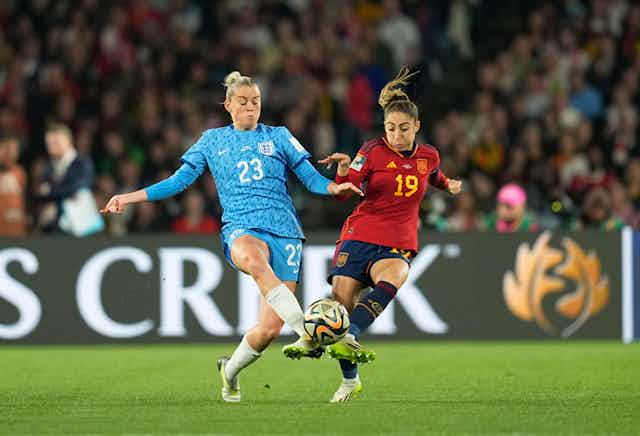England reached the 2023 Women’s World Cup final but couldn’t overcome a Spanish side who were tactically intelligent and dominant in possession, losing 0-1.
But vocal support for the Lionesses was unwavering as the minutes counted down and devastation looked increasingly likely. Watch parties across the country on Sunday morning were full of passion.
Fans roared when goalkeeper Mary Earps saved a potentially game-killing second-half penalty and held their breath when star performer Alex Greenwood received medical attention. Support of England’s World Cup journey has been phenomenal.
As my colleagues and I have recently found from research, greater visibility for the women’s game leads to more scrutiny – and more pressure on those in charge.
Those in leadership positions in women’s football at the Football Association should now turn their attention to building on this support, keeping interest in women’s football high – and most importantly, giving England’s women the best chance of going one step further at the next World Cup and the one after that.
Winning with kids?
The Spanish team was defined by their youth – they were the youngest team to reach a Women’s World Cup final since 1995. But England were a young team too. Their average age of just under 26 years makes them the youngest England squad to reach a major tournament since 2009.
On the face of this, it seems that both countries have a bright future as these players develop in experience. But the best national teams in the world are consistently successful at youth as well as senior levels.
This demonstrates the strategic importance of a talent pipeline, and with it the quality of talent identification and player pathways in the domestic women’s game. The Spanish women’s team are current holders of the under-20 Women’s World Cup title and have won the last two under-17 Women’s World Cup tournaments. Spain star Salma Paralluelo has won both these competitions, and now the World Cup too.
Many of the women in England’s team have stories of adversity overcome on their path to become professional footballers: low wages, travelling to remote training facilities and working multiple jobs. Making the path to becoming a Lioness smoother and focusing on developing young talent will be vital.
Keeping girls playing football is the first step. Before the Lionesses’ Euro 2022 win, only 63% of schools in England offered equal access to football for both boys and girls. Following an open letter from the tournament-winning England squad, the government pledged equal access. England’s injured captain Leah Williamson recently published a book aimed at persuading girls to keep following their passions.
The second step is ensuring the structures that girls play in best supports a senior career in professional women’s football. Training environments vary a lot between clubs, but girls in club academies will generally train once or twice a week and play up to one competitive fixture each week.
Investing in youth
This is a far cry from the men’s game, where boys will train and play far more regularly. They receive high quality sport science support to help them train effectively. The long-term strategy of the Premier League’s elite player performance plan (EPPP) has improved the quality and consistency across audited men’s academies over the past ten years to become a world-class youth development system.
While the levels of investment might be vastly different, there are strategic principles that the women’s game can learn from the men’s.
Shortly before the Women’s World Cup, the Football Association announced 20 club licenses were being awarded to some Women’s Super League and Women’s Championship clubs under a new player pathway named FA professional game academies. These will replace the current Women’s Super League academies.
Clubs have been awarded either a category one license, meaning that the FA will support the development of two age groups, or a category two licence (one age group supported).
The revamped pathway offers some youth level consistency at the very top. It is a fantastic step in the right direction to support high-performing players who come from the FA’s Emerging Talent Centres into women’s academy football. But with only 20 clubs signed up, my fear is that this investment and change doesn’t go far enough.
My latest research with colleagues shows women’s football in England is at a crossroads. Revenue is increasing – but so is debt. Strategic improvements to domestic governance, commercialisation and financial sustainability are needed. But as well as improving the professional game, more attention must be paid to the youth system.
Unless there is an overhaul of the youth development system in the women’s game, stories of adversity in our Lionesses will continue – and our ability to consistently produce international tournament-winning squads at youth and senior levels will by no means be a given.

